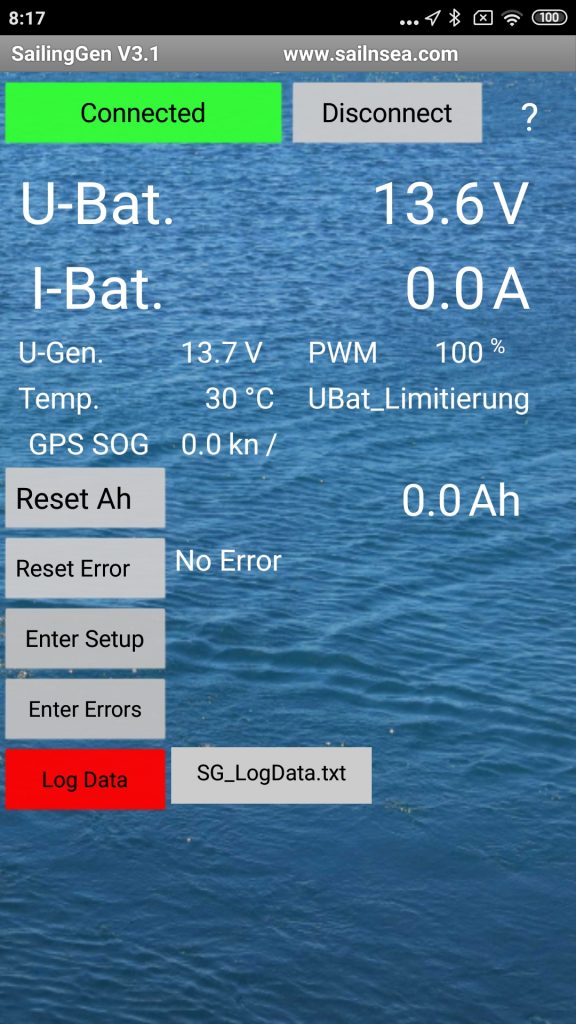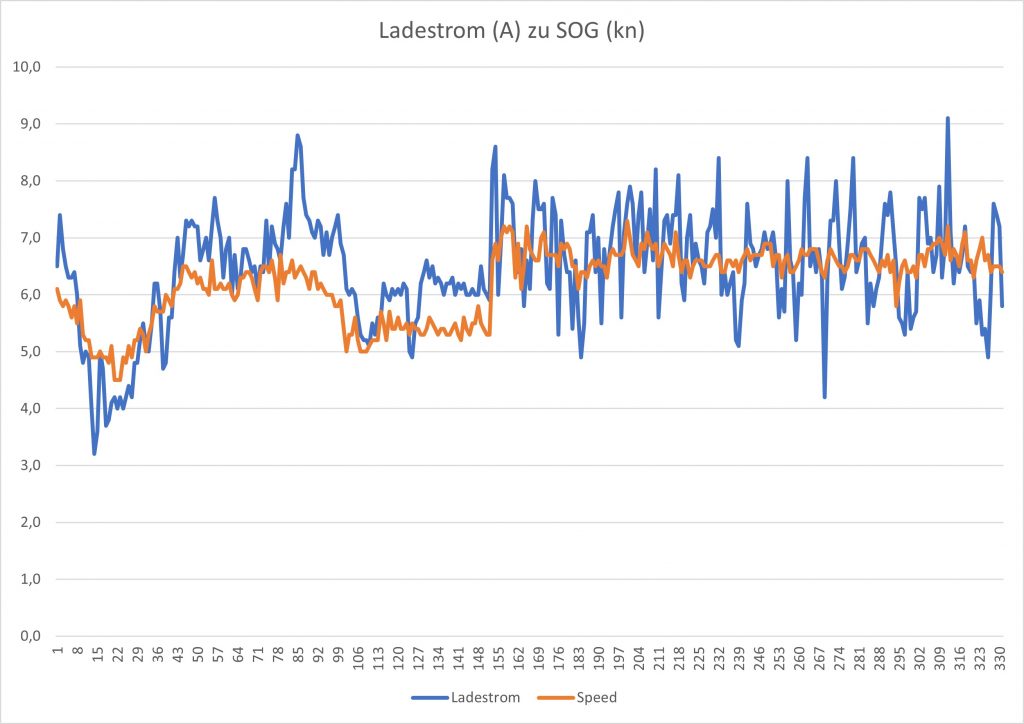When the ship is at anchor, about 3-4 amps are constantly being drawn from the consumer battery by refrigerator, light and other devices. This can be compensated quite well by a solar panel on the sprayhood in combination with the existing EFOY fuel cell. When sailing, on the other hand, 7 – 8 amps are easily drawn permanently. This is especially due to the navigation computer, radar, external screen in the cockpit, autopilot, etc. When the level of the consumer battery slowly approaches 60 % on a longer trip after sailing through the night, the first worry lines appear on the skipper’s forehead and, despite the perhaps beautiful sailing wind, he considers starting the engine – just to charge the battery.
To be able to avoid this, I considered a hydro generator as an energy supplier for underway. The idea was simply to get electrical charging power reliably, unobtrusively and exactly when it is needed, namely when the ship is sailing and the engine is not running. Wind generators would also fit this application scenario to a certain extent (with the exception of longer downwind courses). However, since I didn’t really like the sight and sometimes the noise of wind generators on other ships, I concentrated on hydro generators from the beginning.
In PALSTEK Magazin 2/2021, a very informative article presents and compares various hydro generators and describes how they work. What I found helpful here was not least the information on the requirements for charge control depending on the battery type and the fact that the generators must not run without load, otherwise they will be destroyed quickly.
The compact, light and robust construction of Prof. Armin Horn’s SailingGen (SailingGen Shop) and the reasonable price convinced me. Better than a web shop, however, is the direct exchange, which I can only recommend here. With a short enquiry by e-mail, contact is quickly established and in the following exchange, which sometimes takes place by telephone, various questions can be clarified quickly and competently, especially about the installation of the SailingGen on board and the electrical installation. After the feasibility has been clarified so far, I order the production and get the good piece delivered to my house by post after just under 4 weeks.
Generator and controller are separate units. The generator supplies three-phase current to the controller to be mounted below deck, which regulates the charging system. The final charging voltage and other parameters are displayed or can be set via the app or a control panel that has to be ordered separately. The Palstek 2/2021 (p. 77) provides further details:
“Warnings of possible overload are given visually on the display and also acoustically via buzzer, and status messages and notes are also displayed. The controller functions using pulse width modulation (PWM), so that when the programmable end-of-charge voltage is reached, the generator is clocked in such a way that only as much energy is supplied as, for example, the onboard instruments need. An Android app displays all the controller information via Bluetooth and also allows the controller to be programmed. Charging LiFePo batteries with an internal battery management system (BMS) is possible if the final charging voltage of the regulator is set slightly lower than the cut-off voltage of the BMS.”
The mounting of the bracket is quite simple with 4 screws, once you have found a suitable location in terms of strength, accessibility for operation and electrics. The components of the bracket can be adjusted quickly and easily and thus adapted to the specific conditions (e.g. inclination of the rear view mirror). In my case, the rear steps proved to be the best mounting option. I had a 5 mm stainless steel plate cut and drilled as an adapter between the rear steps and the bracket. The bracket supplied is designed in such a way that it folds upwards if it hits an object in the water. The electrics including the charge controller are quick and easy to install. The installation and operating instructions are very detailed and clear and are sufficient even for the technical layman.
Before leaving, the SailingGen is fixed in its bracket at the stern and held in its ready position by a tether. During the journey, it can then be lowered via the line and thus put into operation. Before entering the harbour, vice versa. The handling is very simple and convenient. During operation, there is a quiet whirring noise, which is no longer noticeable from 2 – 3 Beaufort due to the water and wind noise. Here is a short video illustrating the handling.
Under load, the controller easily reaches temperatures of 40 degrees Celsius and more, so a suitably well-ventilated installation site is advisable. Status, performance and settings, as well as logging if required, can be controlled via an Android app:

The delivered charging voltage as a function of the ship’s speed is as follows after the first tests:

It should be noted, however, that the reported speed as SOG comes from the smartphone and does not consistently correspond to the speed through the water (STW), which is decisive for the performance of the SailingGen.
Conclusion: The compact and robust yet lightweight construction is appealing. Handling is simple, the installation and operating instructions provided are clear. The SailingGen is pleasantly quiet in operation and delivers good charging performance. The price is reasonable and the manufacturer’s advice before and after the purchase is good. A reduction in boat speed due to the operation of the generator is not noticeable and if at all then in my opinion so small that it can be neglected. It is a very pleasant experience to arrive at the anchorage or port of destination with a full battery after a long trip.
-
Recent Posts
Recent Comments
- Calypsoskipper on Expose Finngulf 39
- Christian on Expose Finngulf 39
- Calypsoskipper on Expose Finngulf 39
- Kenneth Melcher on Expose Finngulf 39
- alex on Saildrive diaphragm – replace according to instructions or just keep?
Kalender
January 2026 M T W T F S S 1 2 3 4 5 6 7 8 9 10 11 12 13 14 15 16 17 18 19 20 21 22 23 24 25 26 27 28 29 30 31 Tags
12 V Verkabelung 12 V wiring Anchor windlass Ankerwinde Biscaya Bora Segel Bretagne Brittany Camaret sur mer circuit distribution Cornwall Cowes Cuxhaven Den Helder Diaphragm English Channel Falkenberg falkenbergs Båtsällskap Falmouth Gezeitensegeln havarie Hydrogenerator Lewmar Ocean Membrane MiniPlex-3USB-N2K Nordsee Norwegen Oxley Parasailor Plymouth Ramsgate Saildrive Saildrive diaphragm Saildrive Membrane SailingGen Seenotrettung Segeln in Tidengewässern Sjöräddnings Sällskapet Skagen Skagerak Stromkreisverteilung tidal navigation tidal water routing Tidennavigation ÄrmelkanalArchiv
Kategorien
